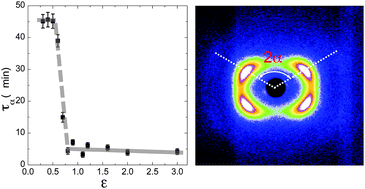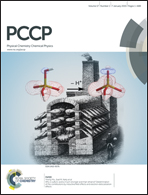Dual relaxation and structural changes under uniaxial strain in main-chain smectic-C liquid crystal elastomer
Abstract
The relationship between strain-dependent macroscopic elastic behavior and the changes in microscopic structure of the smectic-C liquid crystal elastomer (LCE), C11MeHQSi8 were investigated using synchrotron X-ray studies. At very low strains ε ≤ 0.2, the smectic layers are randomly oriented. As the strain increases beyond 0.2, the smectic layers reorient and become parallel to the direction of the applied strain. The polydomain to monodomain (P–M) transition accompanied by the formation of chevron structure ensues for ε > 0.2 and is nearly complete for ε = 0.7. The chevron structure relaxes after the applied strain changes, with a time constant τα ∼ 45 min while the orientation order parameters of the mesogenic and elastomeric components gradually increase and saturate at 0.83 and 0.4, respectively at ε = 1.7 which is near the end of the plateau region. Relaxation rates τα for the tilt angle and τd corresponding to the smectic layer spacing both become about 10 times faster when the strain exceeds 0.7. The LCE remains “locked” into the monodomain state and retains 90% and 80% values of α and S, respectively for 24 hours after the applied strain is removed. The viscoelastic properties of the liquid crystal appear to dominate the equilibration process at low strains while the elastomeric properties control the system's response at high strains.


 Please wait while we load your content...
Please wait while we load your content...